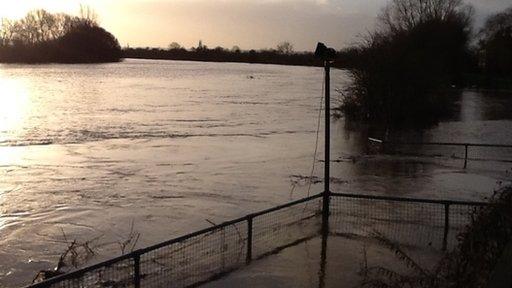Flood defences: Treasury unveils £2.3bn for schemes to protect homes
- Published
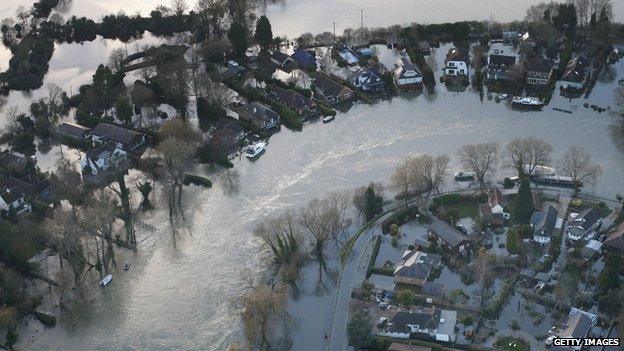
Homes near Walton-on-Thames, Surrey, were surrounded by flood water in February
More than 1,400 flood defence projects, external are to receive funding to protect 300,000 homes, the Treasury has said.
The £2.3bn investment, which is not new money, will help prevent £30bn damage in areas including the Thames and Humber Estuaries in the next six years.
Other infrastructure, including roads, rail and the new garden city of Bicester have also been outlined this week ahead of the Autumn Statement.
Labour accused ministers of "playing catch-up on flood defences".
Shadow environment secretary Maria Eagle said the government had cut the flood protection budget by more than £100m a year, and was "promising to put some of that back, but perhaps not until towards the end of the next Parliament".
However, Environment Secretary Liz Truss told the BBC the government had spent £3.2bn in total on flood defences, "more in real terms than over the previous parliament because we recognise flood defences are vitally important for homes, for prosperity".
The Committee on Climate Change (CCC) welcomed the funding, but said maintenance of existing defences was being neglected.
How flooding in Somerset earlier this year left communities under water for more than a month
The CCC - an independent body that advises the UK government - told BBC News only a quarter of flood defences were being maintained fully. This means the remainder will degrade and need replacing at extra expense.
The condition of assets was in decline before the storms of last winter, mirroring the reduction in maintenance spending over the period, it said.
According to the CCC, the Environment Agency now had 800 fewer flood risk management staff than in 2010-11, including in asset management and incident control.

Among the £2.3bn investment is:
£196m for Thames Estuary projects which ministers say will reduce the risk to more than 8,000 properties
£80m for Humber Estuary improvements, including sea defences between Immingham to Freshney and flood frontage in Hull
£42m for a flood alleviation scheme in Oxford
Funding for schemes in Boston, Lincolnshire (£73m), Rossall, Lancashire (£47m), and the Tonbridge area (£17m)
£15.5m for flood defences in Somerset benefitting 7,000 properties - including £4.2m on the Somerset Levels and Moors. This is part of at least £35m committed to Somerset from this year until 2021.
Surrey County Council leader David Hodge said that giving £196m to the Thames Estuary would leave the seven local authorities in the area searching for a further £120m for the flood defence projects needed.
He told BBC Radio 5 live his county had suffered especially badly with 1,600 homes flooded and 300 families still out of their homes.
Referring to the sum allocated by the government, he added: "That, I'm afraid to say, will not help us."

Some residents living near the Humber say they are waiting for repairs to their homes to take place after flooding last winter.
Lisa Moss said her family are still living in upstairs rooms and told the BBC of her frustration.

'Dreading the winter'
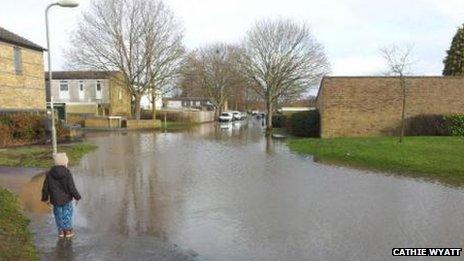
The housing estate where Cathie Wyatt lives in Buckskin, Hampshire, was flooded in February - only a handful of residents have returned and 86 people lost their homes, she told the BBC.
"What has been done since is minor maintenance work; sweeping leaves, cleaning gullies, etc," she said. "No major work has been completed to prevent it happening again.
"We have no more drainage. The area we have soaks anyway and the properties are built on chalk.
"We are all living on our nerves dreading the winter."

A Treasury spokesman said it was spending £171m on maintenance this year and had restored the Environment Agency budget to the same in cash terms as in 2010-11 (behind inflation).
It was working with the Environment Agency to improve efficiency, the spokesman added.
But he stressed that the National Infrastructure Plan, external (NIP) announcement for capital investment in major defences significantly reduced risk to households in highly vulnerable areas.
Danny Alexander, chief secretary to the Treasury, said: "We all saw the destruction and heartache caused by flooding last year and that is why this investment is vital to build Britain's defences for the future.
Danny Alexander MP: "It's an unprecedented long-term capital investment in flood defences"
"The projects we are announcing today will protect some of the country's most at-risk locations ensuring that we will be as prepared as possible for future severe weather."
Guy Shrubsole, of Friends of the Earth, said the money set aside for flood defences was "certainly not enough to keep pace with climate change in the future".
He added: "We need to be doing far more to protect households and to prevent climate change in the first place."
Professor Richard Ashley, from Sheffield University, who advised a government inquiry into floods, said ministers were using "smoke and mirrors" to portray their plans. He referred to the fact that more money was being spent between 2011-15 and said the announcement was only "bringing some sort of stability".
The NIP, published ahead of the Autumn Statement, sets out how the government will spend money on major infrastructure projects.
Other schemes in the NIP, as outlined in a written ministerial statement, external, include:
A £1bn project to build the world's first power-generating tidal lagoon, in Swansea Bay
A £15bn "roads revolution", external for England
Bicester becoming a garden city
A new housing scheme in Northstowe, near Cambridge, that will see a development of 10,000 homes built.

Analysis
By Roger Harrabin, Environment Analyst
Critics will accuse the government of finding the cash for headline-grabbing projects while neglecting existing assets.
The committee thinks lack of maintenance may have caused some defences to fail in past storms.
The government appears to be following the logic that it is better to invest in big new projects in high-risk areas while allowing maintenance of some existing defences in low-risk areas to slip behind.
Flood defences took a battering in last winter's storms but the Treasury said it expected that 96.4% of the most important defences would be back at target condition by April 2015.
Follow Roger Harrabin on Twitter @rharrabin, external

BBC deputy political editor James Landale said the "entire week of announcements" from the government was intended to "crowd out" what opposition parties wanted to say.
But while setting out the "good news", official figures are expected to show "the deficit is not falling as fast as expected" this year, he added.
The UK deficit has fallen since 2010 but was £97.5bn in the year to April.
The CCC said it was not yet convinced the UK was properly prepared for floods as climate change threatened to make extreme weather worse while 4,000 homes a year were still being built in areas of significant risk.
And the Chartered Institution of Water and Environmental Management has warned that more cash still might be needed to combat surface water flooding if the UK continued to experience the sort of violent downpours which had caused havoc in recent years.
- Published27 November 2014
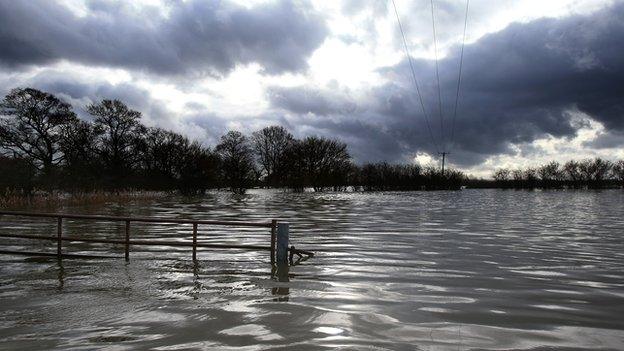
- Published19 March 2014
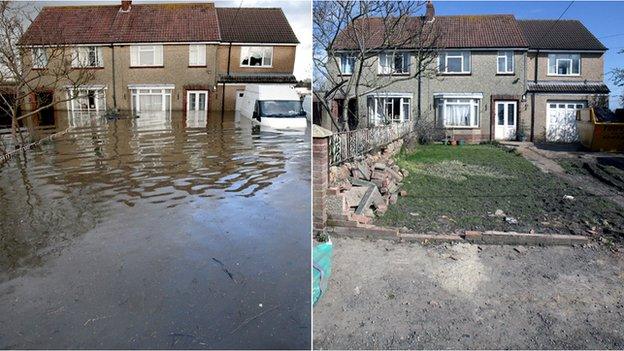
- Published5 November 2014
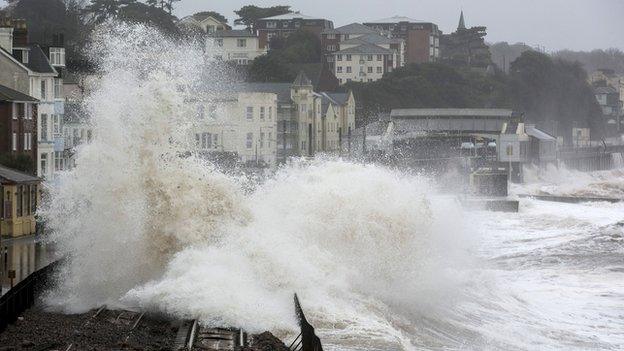
- Published3 January 2014
